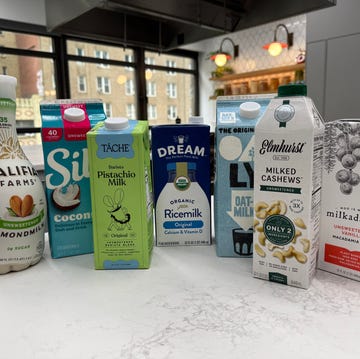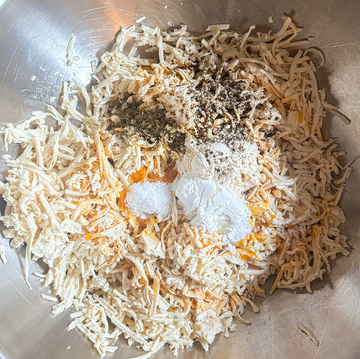Listen up, tea drinkers. It's common knowledge that tea offers an array of health benefits — from reducing inflammation to warding off cancer — but there could be a hidden villain steeping in your daily mug. And that's the tea bag itself.
A recent study published in the scientific journal Chemosphere found that tea bags steeped in boiling water (aka every tea bag if you're making your cup of tea right) can release both micro and nanoplastic particles into your tea, which are then ingested and absorbed into your intestinal cells. These microplastics are notorious for finding their way into everything from your fruits and veggies to your seafood.
And these pesky tea cup microplastics aren't just shedding minuscule amounts either. Researchers found that typical tea bags release approximately 1.2 billion particles per milliliter. This is roughly 5,000 times more particles per liter that the 240,000 particles than you’d find in your average 1-liter water bottle.
Why Do We Care About Microplastics?
Since studies on microplastics have focused on how these particles affect rats, it is still not totally clear exactly how these microplastics impact the human body, but non-human studies have shown us enough to make us cautious, explains Heidi McIndoo, MS, RD, LDN. "Because we aren't yet sure what MPs do to our body, it's difficult to determine how much is too much or what a safe level is," she says. It is known, however, that "harmful chemicals and pollutants can also cling to these particles, further increasing risks when consumed," she says.
Based on the studies done on rats, we can conclude that these tiny plastic particles, which are typically less than 5 mm in size, accumulate in our bodies and are stored as fat, disrupting hormone balance, the digestive system, and immunity, according to certified gastrointestinal nutritionist Alyssa Simpson, RDN, CDN, CLT.
"These plastics are concerning because they don't break down easily and may cause various health issues, including problems with the gut and other bodily functions," says women's health expert and registered dietitian nutritionist Lauren Manaker, MS, RDN, LDN, CLEC, CPT.
A study published in the journal Nature Medicine just this month found that microplastics in humans are on the rise in the past eight years, with toxins discovered in brain, liver, and kidney tissue. Of particular concern, the researchers undertook an analysis of brain tissue from 12 deceased dementia patients revealed microplastic concentrations three to five times higher than those found in normal brains.
"At this point, minimizing your intake of MPs as much as possible is a good idea," says McIndoo.
Do All Tea Bags Contain Microplastics?
The good news here is that not all tea bags contain microplastics. However, the majority of commercially sold tea bags tested did. (Handmade and independently sold bags were not tested.)
Why do companies even use these in the first place? As Simpson explains, the material provides convenience — often in the form of a sealant or mesh insert to help with steeping — and durability to the tea bags.
Because traditional paper tea bags are less likely to shed these particles, Manaker recommends shoppers avoid brands that use plastic tea bags or plastic adhesives on their paper tea bags. She also suggests avoiding any brands that promote their bags as "pyramid" or "silk." These are usually made of nylon or polypropylene and, she says, tend to be the “biggest offenders.”
What Does This Mean For Tea Drinkers?
Like all things in life, the impact of microplastics in tea will depend on how often you drink tea and how each individual body reacts to the toxin. "Occasional tea drinkers may face lower exposure and thus may not need to be overly concerned, whereas daily tea drinkers could experience cumulative exposure over time, " Manaker states.
However, even those who don't imbibe tea daily can still be ingesting enough microplastics to be a cause for concern. "It's kind of sneaky like that," explains Simpson. "Little bits here and there build up over time. So even if you're just having a cup once in a while, it still adds to the total."
How To Reduce Your Intake Of Microplastics From Tea-Drinking
"Fortunately, when it comes to tea," explains McIndoo, "it is fairly easy [to eliminate microplastics] without drastic of fanatical measures." A tea lover’s best bet is to avoid tea bags and instead buy loose-leaf tea and use either a mesh strainer or tea ball. The next best option, explains McIndoo, is to look for tea packaging that explicitly states that the bags are biodegradable, plastic-free, or plant-based.
"Just make sure the bags are free from synthetic materials and are truly biodegradable, as some paper bags still contain plastic fibers for strength," says Simpson.
Bottom line: "If you're concerned about the environmental impact, or worrying about long-term health, it might be smart to make the change sooner rather than later," says Simpson. However, she cautions you not to totally freak out. Manaker concurs, saying, "More data is needed to truly know how much is too much and when to be concerned. Drinking tea in general is a healthy addition to an overall diet."
If you simply can't give up the simplicity of a tea bag, our experts recommended some of their favorite brands that use plastic-free packaging for you to enjoy.





















